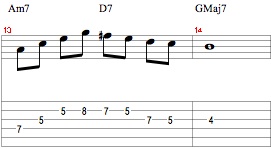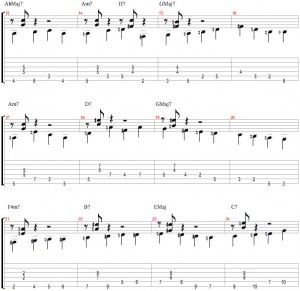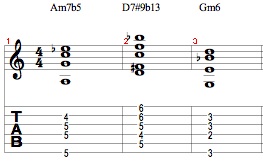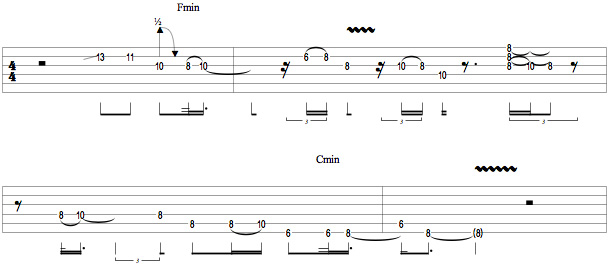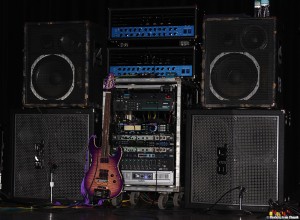The ii-V. All hail the ii-V. Never question it. Accept it. Embrace it. And then once you’re sick of it you can puke it out all over the place. The ii-V-I progression is the most important chord progression in Jazz music, equitable with I-IV-V in Pop music. There are tunes with harmony constructed solely on the ii-V, and it appears in about 85% of the standard repertoire.
So if you want to play Jazz, then it’s a good idea to get to know this guy. He’ll get you a long way. Let’s figure out how to construct, play, and play over the almighty II-V progression.
Let’s start by constructing these suckers. The diatonic II chord will be a II minor 7 (IIm7) and the V will be a dominant 7 (V7), and when it resolves it will go to the I major 7 (IMaj7). So in the key of G we will have Am7-D7-GMaj7. Common voicings are shown below (although there are a whole world of possibilities that I will cover in the future).
Example 1:
Standard voicings for the ii-V-I in the key of G Major.
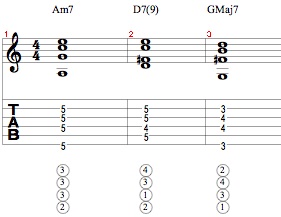
So now that we know these chords, lets go ahead and play some tasty licks over them. There are a TON of ways to play over a II-V progression, and every expert Jazz musician seems to have his/her own concept of how to do it (and consequently a book on it). You can get by playing the root scale that the progression is based out of. So for Am7-D7-GMaj7 you would use a G major scale. Simple enough, and a good starting point, but we can take it a step or two further.
It is important to know the ins and outs of every chord you are playing over in the Jazz idiom, because the more you know, the cooler your solo could potentially be. So we start with the scale for each of the chords. This is pretty simple in that they each get their respective scale relating to the home key. Am7 – the II chord – would get an A Dorian scale. D7 – the V chord – gets Mixolydian. GMaj7 gets a regular G major scale, but a lot of Jazz players will use a Lydian scale for some extra color.
Example 2:

The final and most crucial step is learning some licks to play over a II-V progression. A strong vocabulary of some interesting licks will get you a long way when you’re improvising over Jazz standards. Practicing licks and really getting them ingrained in your ear is a huge step in actually sounding like a Jazz guitar player. There are a couple examples of some basic licks below. Be sure to practice them as well as write some of your own!
Example 3a:
Example 3b:
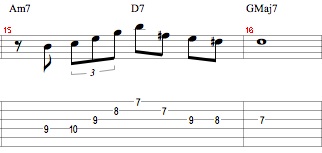
Example 3c:

The ii-V is easily the MOST important chord progression in traditional Jazz, so learn it well. Learn to tame it and it will serve you most fruitfully in the future. Next month I will cover the altered scale, which is crucial to the second part of my ii-V lesson, the Minor ii-V.
Notes:
- The voicing of D7 I use is actually a D7(9). It has a tension note in it that will be explained in a future article.
- There IS Jazz music that does not use the II-V progression in any way shape or form. Despite popular opinion, Jazz music has evolved dramatically over the past 20 years and there are a lot of awesome bands like Kneebody, Happy Apple, and Vijay Iyer that are doing mind-blowing new stuff. Oh, you may have heard of Kurt Rosenwinkle, too. My article focuses on a foundation in Traditional Jazz, so that’s what I am showing you here.



